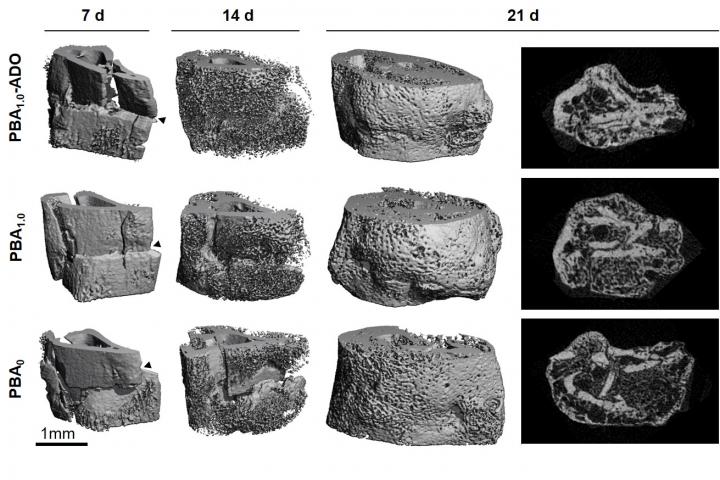December 13, 2019 -- Researchers at Duke University have engineered a bandage that captures and holds a pro-healing molecule at the site of a bone break to accelerate and improve the natural healing process. The proof-of-concept experiment was conducted in mice, and the results were published on December 12, in Advanced Materials.
Improving mechanisms of tissue repair is of great interest to many researchers. The current research suggests a general method for improving bone repair through the application of biodegradable bandages, implant coatings, or bone grafts.

The current work is based on previous research that found that adenosine, a purine nucleotide base found in ATP, plays a particularly large role in spurring bone growth. The researchers found in the previous study that the body naturally floods an area of bone damage with adenosine molecules, but that the molecules are quickly metabolized and utilized.
"Adenosine is ubiquitous throughout the body in low levels and performs many important functions that have nothing to do with bone healing," said Shyni Varghese, professor of biomedical engineering, mechanical engineering and materials science, and orthopedics at Duke. "To avoid unwanted side effects, we had to find a way to keep the adenosine localized to the damaged tissue and at appropriate levels."
In the current work, the team developed a mechanism to assist the body during repair by allowing adenosine to remain in the localized area for an extended duration. They designed a bandage that when applied directly to broken bone provides boronate molecules which bind to adenosine, provided a slow release rate of adenosine over time, thereby regulating accumulation throughout the body.
Researchers validated that biomaterials incorporated with boronates were able to capture local adenosine molecules following an injury. Then, using mice with tibia fractures, the team applied bandages primed with boronates to capture endogenous adenosine or bandages pre-loaded with adenosine. After a week, mice treated with both types of bandages had faster healing than those without bandages. Adenosine promoted accelerated healing of osteoblastogenesis and angiogenesis. And after three weeks, the bandaged mice showed better bone formation, higher bone volume, and better vascularization.
The results showed that not only do the adenosine-trapping bandages promote healing, they work whether they're trapping native adenosine or are artificially loaded with it, which has important implications in treating bone fractures associated with aging and osteoporosis.
"Our previous work has shown that patients with osteoporosis don't produce adenosine when their bones break," said Yuze Zeng, a graduate student at Duke University. "These early results indicate that these bandages could help deliver the needed adenosine to repair their injuries while avoiding potential side effects."
In the future, the researchers hope to design biodegradable bandage that traps adenosine to help heal broken bones and then decomposes into the body. Or for osteoporotic patients, a permanent bandage that can be reloaded with adenosine at sites that suffer from repeated injuries. They also envision a lubricating gel armed with adenosine that can help prevent bone injuries caused by the wear and tear associated with reconstructive joint surgeries or other medical implants.
"We've demonstrated that this is a viable approach and filed a patent for future devices and treatments, but we still have a long way to go," said Varghese. "The bandages could be engineered to capture and hold on to adenosine more efficiently. And of course, we also have to find out whether these results hold in humans or could cause any side effects."
Do you have a unique perspective on your research related to biomedial engineering? Contact the editor today to learn more.
Copyright © 2019 scienceboard.net


